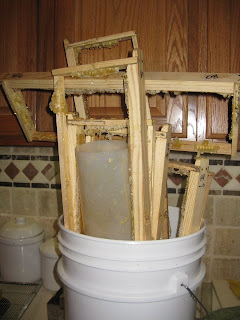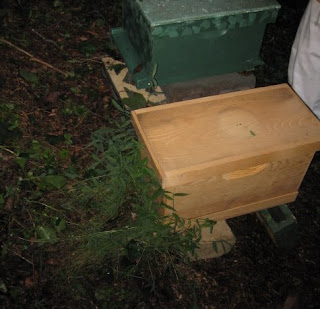This post is full of random hodge-podge from my inspection and harvest this weekend.
Remember the hive where the
comb was being built only on 2/3 of each frame in the super? I posted on the Beemaster forum, and I received replies suggesting that the bees would continue in this hive to build comb only in the front 2/3 of the box unless I took action. The recommended action was to turn the box 180 degrees so that the bees would now have the back in the front and the front in the back. I did this and now they are filling out the frames (see below).

I keep a stick in the back of my telescoping covers to add ventilation to the hives. When I do my inspections, the first thing I remove is the stick.....and then I lose it because I put it down just any old place. Today I decided to keep the stick in my hand until I take off the top cover and place the stick inside the telescoping cover before I take the hive apart. Seems simple, but it's hard to remember to hold onto the stick while I remove the cover. However, it pays off. I was much less frustrated since I could easily find the stick at the time to close up the hive, and I made myself remember to do it with each of the eight hives. Hooray!

Hyron, my first swarm, has been lagging behind the other hives. There is definitely a queen, but although she has a beautiful football shaped laying pattern, the swarm has not been building up as I would like it to. They haven't even considered the upper box. To find out how they really were, I needed to go into the brood box. I opened up the top box and set it on the inner cover.
I removed a frame from the brood box (the only box with any bees in it.) The bees were hot and not happy with me. Immediately they flew out of the hive and fastened themselves onto my jeans. It is so hot that I had opted to use my jacket with a veil that I love from BeeWorks. As a result I was wearing my blue jeans. There were at least 50 bees on my legs. I felt the stings start; put the frame against the hive; and headed for the house.
I could feel the stings through my jeans and tried to brush all of them off. When I finally counted the stings, I had 15 including one that crawled up my jeans and stung my knee and one that slipped under the elastic band on my wrist. Note to self: If I want to wear the veil for an inspection and not my full suit:
1. Don't inspect Hyron, the hot swarm hive
2. Wear loose jeans like my overalls instead of well-fitted jeans.
I don't know why this is such a hot hive, but I get stung every time I open it. Beekeepers will say that I need to replace the queen. I think I'm going to ignore this hive for a while and maybe replace the queen going into fall.
Meanwhile, like a true Southern woman, I felt inspired to feed these bees (we Southern women feed everyone). Maybe they haven't experienced me as hospitable as they expected here in Georgia. I haven't been feeding any of my hives because we've had a good nectar flow going, but these girls must be hungry. The jar which was totally full, had about an inch of feed taken from it since I installed. Maybe this will tame their spirits, but meanwhile it will be a cold day in ,.........before I open Hyron again.

While I was in the hives today, I took off about 9 frames of beautiful capped honey - some pretty enough to cut comb, all of it good for chunk honey. I took the wax cappings/crushings out of my filter from last weekend to make way for the new harvest. I washed it to get it ready for the solar wax melter. Here's the beautiful wax, ready to go outside and melt. There's a lot of it - will take about three different days in the SWM.

That's all for the hodge-podge post!








































